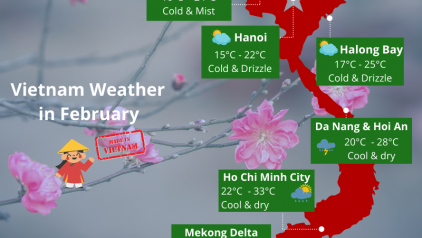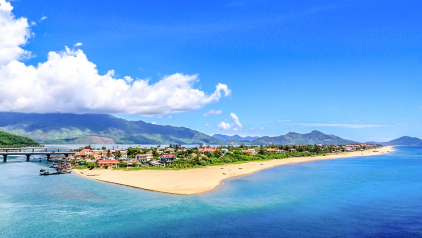Vietnam Weather: Best Time to Visit & Weather Forecast
Vietnam experiences a humid subtropical climate with diverse weather systems from the North to the South of the country. Travelling during most months of the year, you can enjoy both sunshine and rain at the same time. There are two distinctive monsoon seasons: the dry season from November to April and wet season from May to October. Follow our guidelines on Vietnam's weather to choose the best time to visit and enjoy the best climate of the year.
Generally, there are two main seasons in Vietnam, including the dry season (Nov-Apr in the North & South, Mar-Aug in the Central) affected by the cold, dry northeast monsoon, and the rainy season (May-Oct in the North & South, Sep-Feb in the Central) affected by the hot, humid southwest monsoon.
However, with a coastline of more than 3,000 km from North to South, the climate varies greatly over 15 degrees of latitude. Consequently, not the whole country receives moderate sunshine all year round. At the same time of the year, you can soak up the sun on the southern beaches and get frozen in the northern mountains.
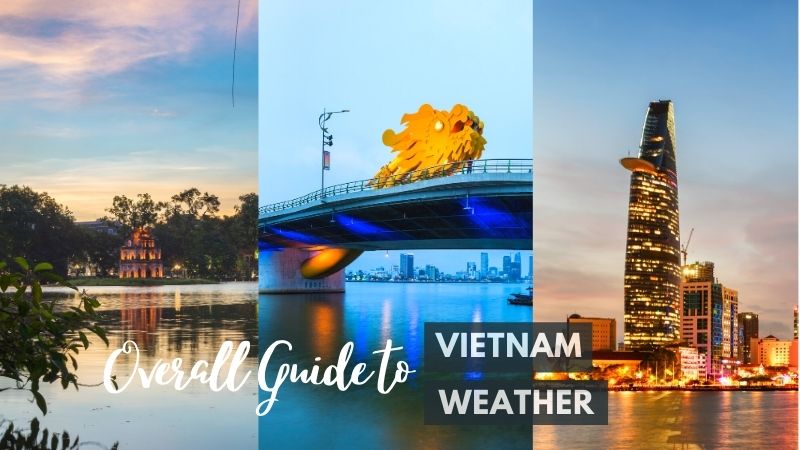
Vietnam weather by region
According to the variation of topography and latitude, Vietnam is divided into three distinct weather patterns: the North, the Central, and the South. If you intend to visit a specific area, please refer to this clarification of regional climate differences below.
North Weather (Hanoi, Ninh Binh, Halong Bay, Sapa)
This region has the most diverse climate patterns representing 4 distinct seasons: warm & humid spring (Feb-Apr), hot & wet summer (May-Aug), cool & breezy autumn (Sep-Nov), and chilly & dry winter (Dec-Jan).
In the North, the humidity level remains around 75-85%, despite the variation of temperature and precipitation. Northern Vietnam temperatures witness a significant change from season to season. While the temperatures in the summer months can reach a peak of 38°C, the winter averages may dip down to 8°C occasionally and even below zero in the mountainous north far. Over the year, July is the hottest month with an average temperature of 29°C. And January, the coldest month, has an average temperature of 15°C. This considerable change may bring some distracting weather characteristics in the transitional season.
Here is an overview of the climate in northern Vietnam by season.
| Season in the North | Average temperature | Weather characteristics | What to pack |
| Spring | 15–25°C | Drizzling, humid, warm | Warm jacket or cardigan, waterproof clothing |
| Summer | 30–38°C | Steaming, heavy showers, rainy season | Loose shorts or jogger pants, a sleeveless tank top, a wide-brimmed hat, sunscreen |
| Fall | 24–30°C | Sunny, dry, calm weather | Long-sleeved clothing, warm layer, cardigan |
| Winter | 10–20°C | Cold, damp, dehydrated, and frosty in north mountain | Windproof jacket, sweater, gloves, wool hat |
All in all, the best time to visit North Vietnam is spring (Mar-Apr) and autumn (Sep-Nov), when you can enjoy the best weather conditions and mesmerizing charm of the beauty spots.
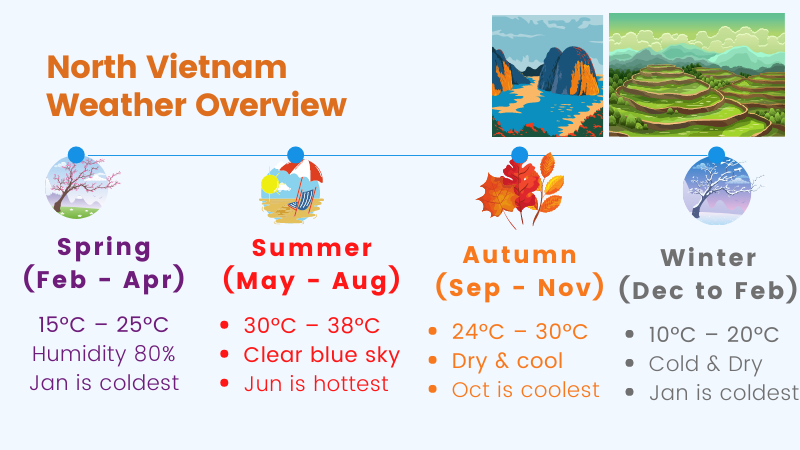
Central Weather (Hoi An, Hue, Da Nang, Da Lat, Nha Trang)
You can feel the similarity to the Northern's weather, with the extremely hot months in the middle of the year. It is also the rainy season when floods frequently occur and produce negative impacts on either transportation or tourism in Vietnam. The Central is divided into three smaller climate zones, including:
- North Central Coast is affected by the northern weather with 4 different seasons as mentioned above.
- South Central Coast features 2 tropical monsoon seasons with high temperatures, a humid climate, and high rainfall. The rainy season falls between September to January with the storm season (Sep-Oct), while the dry season starts from February to August.
- Central Highland is characterized by the tropical savanna climate with many rays of sunshine and cool breezes. The wet season is from June to October and the dry season is from November to May.
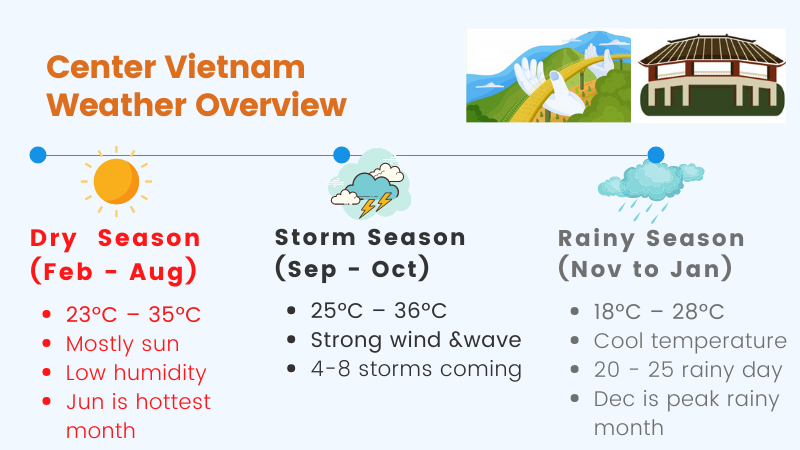
Overall, Central Vietnam weather has dry and rainy seasons, which are quite different from other regions of the country.
| Season in the Central | Average temperature | Average rainfall | Weather characteristics | What to pack |
| Dry season | 22–34°C | 20–105 mm | Dry, hot, moderate sunshine | Summer outfits, a wide-brimmed hat, sunscreen |
| Rainy season | 20–30°C | 35–615 mm | Humid, high precipitation, stormy season, typhoons & flooding | Light sweater, waterproof jacket, light raincoat & umbrella |
Everything considered the best time to visit Central Vietnam is from March to May, the driest months with calm weather and pleasant temperatures.
South Weather (Phu Quoc, Con Dao, Ho Chi Minh City, Mekong Delta)
The southern part features the most typical monsoon climate with year-round high temperatures and constant sunshine. The southern Vietnam temperatures vary constantly around 25-35°C throughout the year. In particular, there are two distinct seasons: the dry (Nov-Apr) and the wet (May-Oct), also called the rainy season.
| Season in the South | Average temperature | Average rainfall | Weather characteristics | What to pack |
| Dry season | 23–38°C | 5–50 mm | 2–7 rainy days per month Low humidity Summery | Swimsuit, summer outfits, sunscreen Light jacket or cardigan for the evenings Waterproof jacket in the rainy season |
| Rainy season | 25–36°C | 115–325 mm | 20–25 rainy days per month Frequent downpours in the afternoon August is the wettest month |
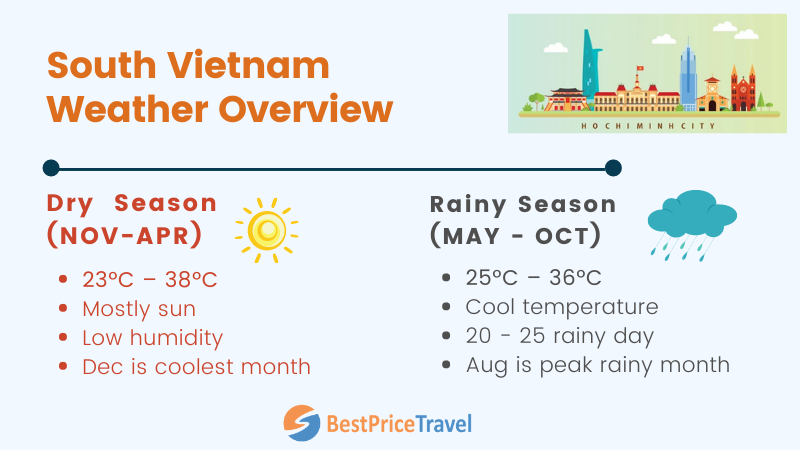
In a nutshell, the best time to visit South Vietnam is in the dry season, especially from December to February. Remember to avoid the months between June and September since typhoon weather receives the highest rainfall of the year.
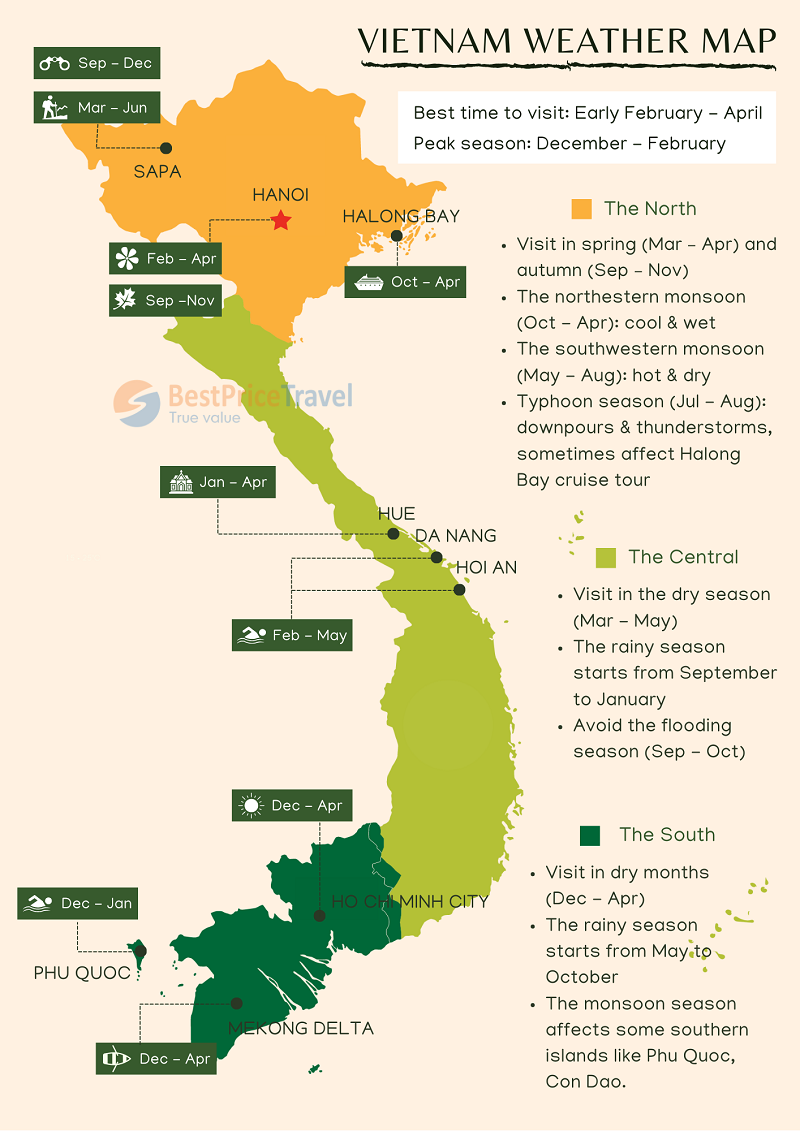
Vietnam Weather Map
